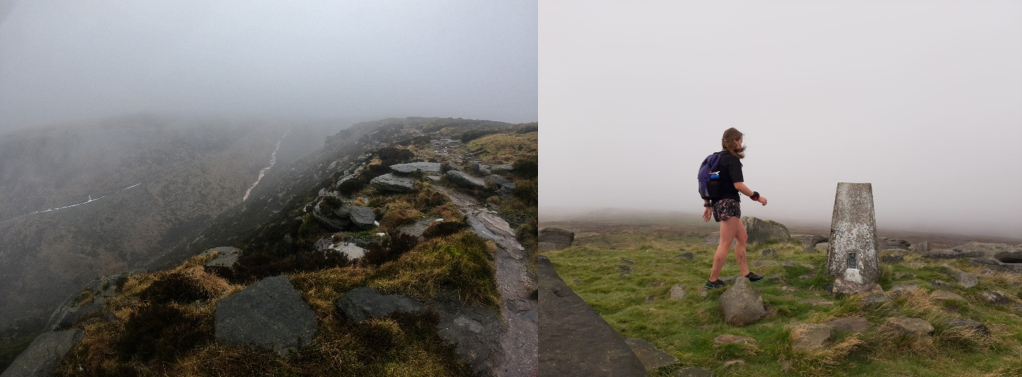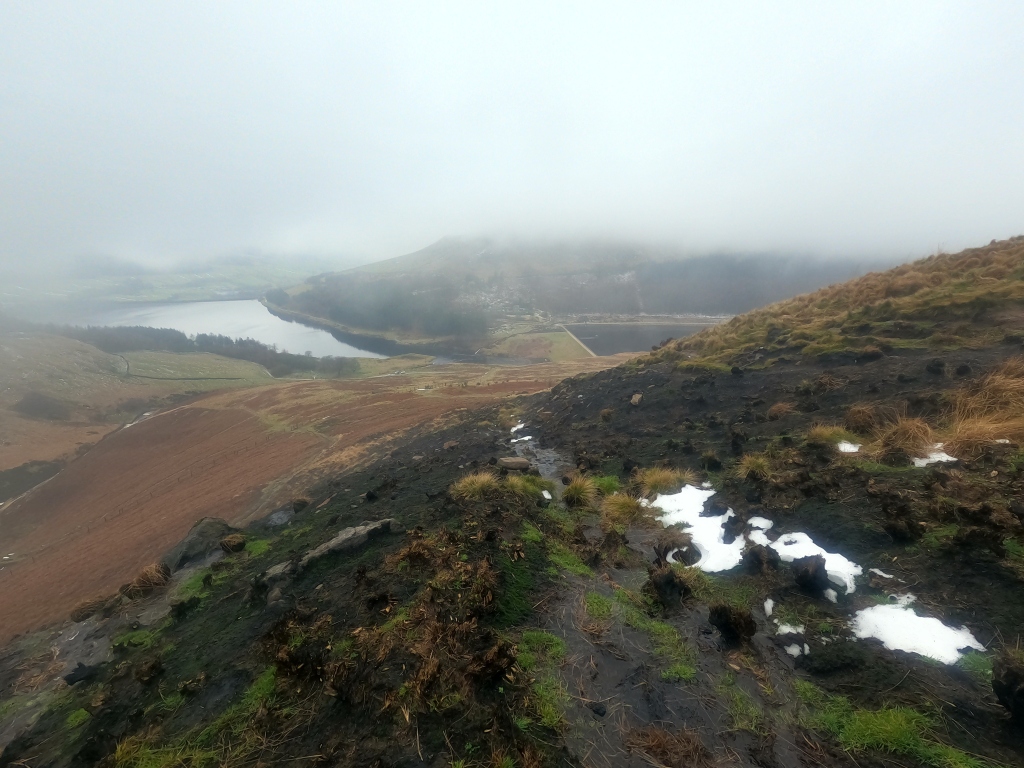
Why am I talking about bogs?!
It is fair to say peatlands are a fell runner’s habitat, considering how familiar we are with bogs attempting to suck us into their depths, and how superhuman we can be in our dance across the moors hoping to avoid such a fate. Although they are superficially bleak, bogs offer the world a great deal more than we realise. They are vast carbon and water sponges that help regulate climate change.

Globally, peatlands cover 3% of Earth’s terrestrial surface yet contain 30% of soil organic carbon which is captured as CO2 during photosynthesis. Sphagnum moss’ role as an ecosystem engineer (organisms that modify habitats, affecting the survival of other species) is vital here. It optimally photosynthesises when holding 400% of its dry weight in water, mostly absorbed from mists typical of infamous boggy landscapes like Bleaklow. Once the moss dies these waterlogged conditions inhibit decomposition, helping lock the greenhouse gas CO2 away into peat, which accumulates excruciatingly slowly at 1mm per year. This latter fact is problematic as we have lost metres of peat since the Industrial Revolution.

The Legacy of The Industrial Revolution.
Although bringing many benefits, this revolution also sparked global air, water, and soil pollution. My local moors in the Pennines are about 15km away from the world’s first industrialised city, Manchester. Ironically, the bogs surrounding Manchester provided optimally damp air for the cotton mills my ancestors worked in, increasing demand for fossil fuel consumption, polluting the air, and depositing acid rain which killed the moss and dried the moors out!
This pattern of industrial development catalysing biodiversity and climate crises has rippled out from England, accelerating across the world’s delicate ecosystems as positive feedback loops of decline begin. Dry, degraded moors erode and catch fire more easily, emitting 2,000,000,000 T CO2 per year (equalling all air travel emissions), subsequently increasing the intensity and frequency of extreme weather events like floods and wildfires that exacerbate this cycle of erosion.

Furthermore, as the moors’ moss cover declines, the rate of water flowing off the hills and straight into our reservoirs increases. Seemingly illogically, this is not good. Naturally, the moss should capture water from rainfall and low-lying mists, slowly releasing it over the drier months so providing a steady yet constant flow to recharge what has been used.


This year, however, pitifully low reservoirs are screaming out that the moors are sick and dying. Additionally, water that does come down from the moor has not been filtered by Sphagnum so carries lots of eroded acidic peat that is harmful to our drinking water, and more importantly, wildlife further downstream.

Contrastingly, healthy bogs are resilient to this spiralling decline and when we consider that the UK holds 13% of this precious global blanket bog ecosystem, we can realise that there is a gift in this. Right on our doorstep is the ability to respond and take climate action, on our very own fell running habitat, with positive environmental and social justice repercussions across the entire world.
What Can Be Done About What Sounds Like Yet Another Depressing Ecosystem Collapse?
This year I finally achieved a long-time goal of mine – complementing my running training with regenerative environmentalism. This has consisted of a jog out to meet my fellow RSPB volunteers at Dovestones Reservoir, completing the task for that day, followed by an easy run back home over the moors. Even without the runs either side the physical benefits for endurance, strength, power, and good old fashioned character building for those tougher races, are plentiful. Low intensity activities include carrying heavy equipment along ankle-rolling terrain to remote sites, developing those crucial proprioception abilities of the ankle, knee, and hip joints! Planting willow stakes to stabilise peat margins requires higher intensity efforts of driving iron bars into the ground to create planting holes. Emphatically jumping up and down on heather bales (that slow water flow and reduce erosion), to strongly encourage them to fit into the hole that just took half an hour to dig, certainly benefits stamina.

My favourite activity involved intentionally wading thigh deep into the sticky bogs themselves, allowing it to seep around my feet and take hold, whilst I planted small handfuls of Sphagnum just below the water surface. Revegetating the moors like this increases their capacity to capture and store carbon and water, all whilst your fell running ability to escape the grasp of the bog is tested Ie. heaven!

Small, Simple Actions.
Although I recognise most people cannot spare the time, nor have the privilege of green spaces nearby, to volunteer in the ways above, the purpose of this blog is to demonstrate just one of many ways outdoor pursuits can benefit the ecosystems we rely on for our training.
There are very simple and direct actions – during the 2018 Saddleworth fires, fell runners were recruited to look out for signs of fires during their training runs. But we must also remember that all global systems are interconnected and so there are many indirect actions (buying peat-free compost; denouncing single-use BBQs*; telling your fellrunning friends about the importance of peat bogs; monitoring your water usage; searching for local citizen science opportunities e.g. Moors For The Future cover the South Pennine Moors) it just takes a small amount of imagination!
Now, go and enjoy those gloriously awesome bogs, perhaps being so quirky as to audibly say ‘thank you’ for all that they humbly do for us in the background:)
*some areas have Public Space Protection Orders banning the abomination that is the single-use BBQ.



